
Company: Viz.ai Product: Viz ICH
Revolutionizing Intracranial Hemorrhage Diagnosis: A Retrospective Analytical Study of Viz.ai ICH for Enhanced Diagnostic Accuracy
Cureus, 2024
Abstract
Introduction
Artificial intelligence (AI) alerts the radiologist to the presence of intracranial hemorrhage (ICH) as fast as 1- 2 minutes from scan completion, leading to faster diagnosis and treatment. We wanted to validate a new AI application called Viz.ai ICH to improve the diagnosis of suspected ICH.
Methods
We performed a retrospective analysis of 4,203 consecutive non-contrast brain computed tomography (CT) reports in a single institution between September 1, 2021, and January 31, 2022. The reports were made by neuroradiologists who reviewed each case for the presence of ICH. Reports and identified cases with positive findings for ICH were reviewed. Positive cases were categorized based on subtype, timing, and size/volume. Viz.ai ICH output was reviewed for positive cases. This AI model was validated by assessing its performance with Viz.ai ICH as the index test compared to the neuroradiologists' interpretation as the gold standard.
Results
According to neuroradiologists, 9.2% of non-contrast brain CT reports were positive for ICH. The sensitivity of Viz.ai ICH was 85%, specificity was 98%, positive predictive value was 81%, and negative predictive value was 99%. Subgroup analysis was performed based on intraparenchymal, subarachnoid, subdural, and intraventricular subtypes. Sensitivities were 94%, 79%, 83%, and 44%, respectively. Further stratification revealed sensitivity improves with higher acuity and volume/size across subtypes.
Conclusion
Our analysis indicates that AI can accurately detect ICH's presence, particularly for large-volume/large-size ICH. The paper introduces a novel AI model for detecting ICH. This advancement contributes to the field by revolutionizing ICH detection and improving patient outcomes.
Read full study